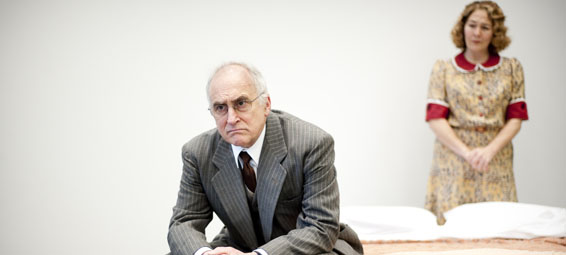Everything’s bigger in Texas. When Dallas Theatre Center takes on an American classic like Death of a Salesman, you know they’ll go big. You just might not expect them to go big with emptiness, but that’s just what they did. Scenic designer Daniel Ostling gives director Amanda Dehnert a stage filled with space. Depending on how you feel about their choices, you may see this production as low tragedy writ large or just much ado about nothing.
It’s a funny thing, scale. It’s the relationship between how big something is to the world around it. In director Dehnert’s version, Willy loses sense of how big he is. Sometimes he sees himself as a man of consequence recognized throughout his territory. Other times he loses his bearings and gets swallowed. Broadway import Jeffrey DeMunn has reduced Willy Loman to three recognizable notes: pride, anger and bewilderment and he can switch between them instantly, heartbreakingly. The opening night audience was fearful for this late model man of the road from the outset recognizing the faulty memory, mood swings and dementia. These things ring louder today than they did in 1949 when the average life expectancy was shorter by ten years. The audience can see where Willy is headed because of our too personal experience with aging and its effects.
Interestingly, the play becomes less about him because of that. As his narrative potential diminishes, Linda Loman becomes more intriguing. Sally Nystuen Vahle plays the long-suffering wife with sensitive strength. Her Linda can heroically surrender to her husband with soothing grace and still overwhelm her two grown sons when the circumstances warrant. When the end comes, all that strength-breaking takes the audience over the edge. The spell held even as the audience shuffled out, keeping the conversations hushed, appropriately respectful as if returning from a funeral, a salesman’s funeral, a requiem for the American dream.
Miller’s classic is a wonderbread wonderland normally, but DTC has seen fit to pepper the salt and give this play ebony and ivory keyboard casting in many roles. There’s no rhyme or reason to the monochromatic color-blind casting, though you may spend a lot of time trying to figure it out. In the end, the colors matter less than the types. Biff, for instance, isn’t shaped like the Adonis he is constantly compared to. And each time, it takes us out of the play for a minute, especially in the flashback football star scenes. This clumsy casting smacked of a summer stock company who’d painted themselves into a corner casting-wise, the long season leaving the pool of players limited. Especially inappropriate because Miller takes pains to reduce his plot and prose to the essentials so as to make his axe sharper.
The audience has to politely ignore the incongruities. Were it not for the majority of the cast coming from the resident company and the casting of traditional leads, something could be said for artistic intent. This criticism is not to take away from the achievements of the actors, however. On the whole, the cast did justice to this song of the unsung. They admirably perform a play that defends this doomed cog of capitalism who doesn’t see his disposability. A man who’s still buying into what he is selling even when others have stopped. (When asked what it was, Miller’s answer was, “Well, he sells himself.”) The similarity to the actor’s plight is striking, only their suitcase is their physical presence and their samples are their experience. Ironically, this production asks the audience to ignore those wares from the outset.
Dallas Theatre Center’s Death of a Salesman is a production of two minds. On the one hand, you have a clean canvas of a set reduced to barest essentials. On the other, you have stagehands slouching on its furniture. Some set pieces like the water heater and fridge are period domestic and others like the table and chairs are modern institutional and would look at home on Law and Order. Finally, you have a standard Willy and Linda but elsewhere confusingly creative casting. This production can’t decide if it wants to be artistic or traditional. It is sort of a defiant revision struggling under the oversized overcoat of a reverent revival. It is a testament to the play that it can carry the day despite the distractions.
Photo: Jeffrey DeMunn and Nystuen Vahle in Death of a Salesman (Courtesy Photo).






